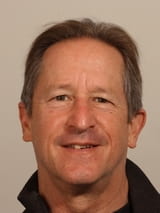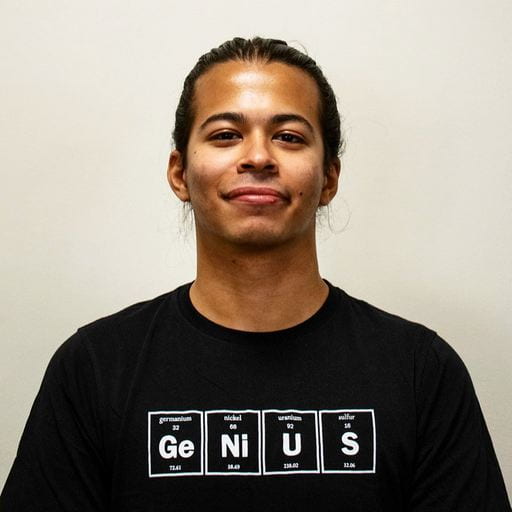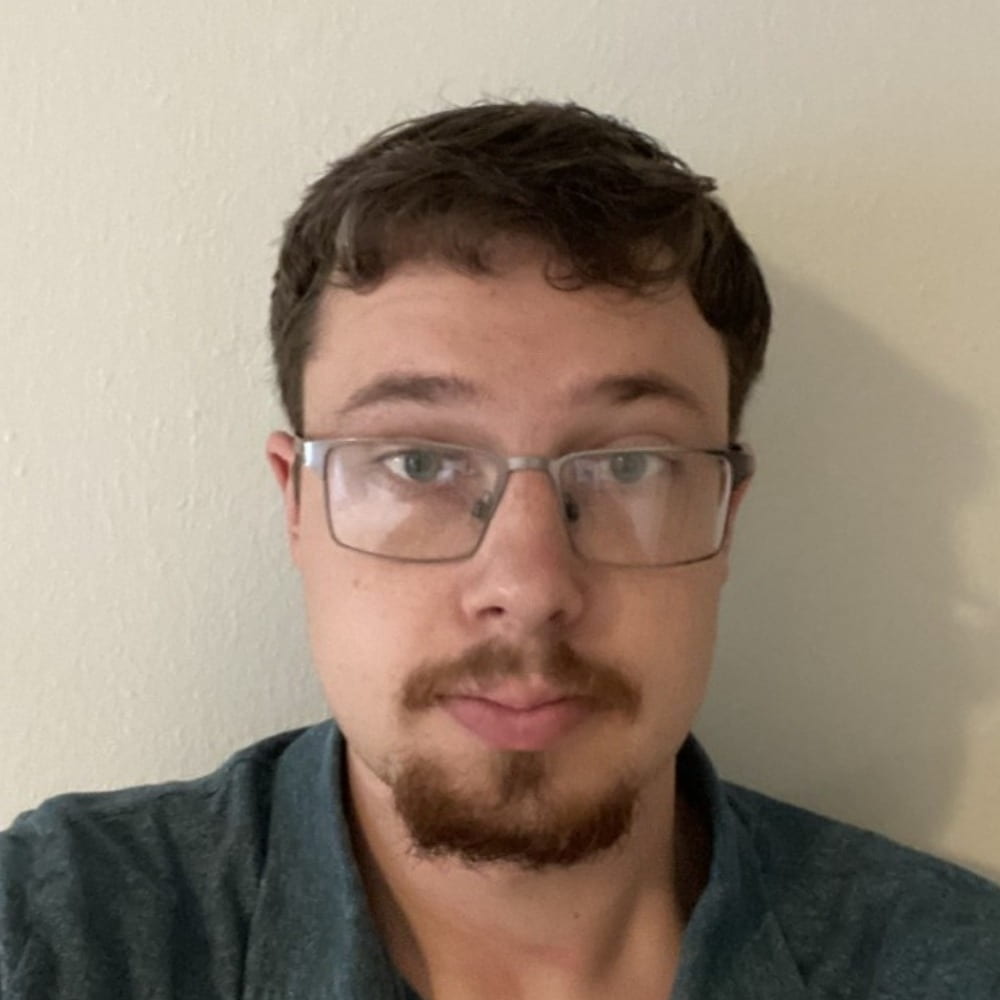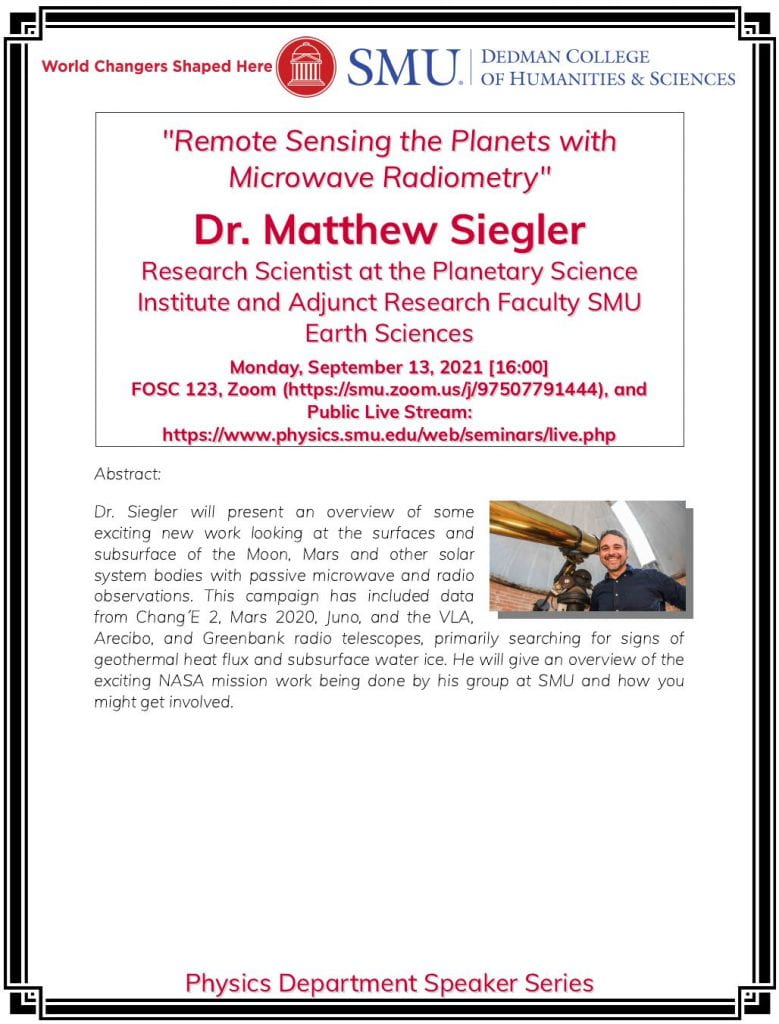
In this edition of the Friday Newsletter, we meet more new members of the SMU Physics community, look ahead to the next Department Speaker Series event, and remind about the importance of mental health.
Contents
CHAIR’S WEEKLY MESSAGE
“Keep on Keeping On”
I’m going to confess something. I like to watch recordings of video games.
I’ve enjoyed this activity since high school, when I realized I could run my Sega Genesis through the VCR (look it up) and into the TV, recording game play as I did so. My goal was then to play a game as seamlessly as possible, letting the cut scenes play through, and save the whole thing like a movie. (For the record, the first time I did this was for the game “Target: Earth”).
It’s 2021. Games have gotten a lot better, more like movies with controllable characters than just some distraction to play after homework is done. I’ve enjoyed watching both of “The Last of Us” games, and now I am working my way in small batches through 26 hours of the game “Death Stranding.” This is my guilty pleasure, a way to reboot my brain at the end of a day that begins at 7am with meetings and work and proposal writing, followed by commuting, more meetings, maybe some actual research, more proposal writing, more meetings, and teaching, and then more commuting. In between getting home and eating dinner, on the YouTube goes “Death Stranding.”
The game begins as a story about broken community and an effort to rebuild widespread human connection after an apocalyptic event known as the “death stranding” that severed the barrier between the worlds of the living and the dead. Sure, the game’s got anti-matter, harps on chirality, boasts a character named “Higgs” (yes, as in THAT Higgs), and certainly lists a top-notch cast to boot. And sure, it’s just a game … but the strange and persistent emphasis on reconnecting people after a cataclysm – even as forces work to keep everyone apart ostensibly to prevent another “death stranding” – weirdly resonates with me right now.
We in the real world have been apart in most ways for about 18 months. Coming back together in the classrooms and on the campus has been liberating, even as we all know that the slip of a mask or the skip of a vaccine may be enough to throw us back into separation and isolation again. Each of us alone, and all of us together, are fighting hard to prevent another COVID stranding. In many ways, and following the themes of “Death Stranding,” getting people back together – teaching in the classroom, talking face-to-face, meeting in person again – is the most important thing we can do for learning, mental health, and general well being. But, as is implied in “Death Stranding,” the ways in which we best connect also may carry with them the threat of spreading COVID-19. It’s a difficult balancing act, one every student, staff member, and faculty member walks every day on campus.
“Keep on keeping on,” says a recorded voice as the main character of “Death Stranding,” Sam Porter Bridges, exits a supply distribution center. Those are the words we are all trying to live by right now.
There is little evidence so far that being back in the classroom is causing widespread COVID-19 outbreaks on campus. Cases rose in the first two weeks of the term, but on the same timescales as last fall and last spring, the peak has not yet matched previous peaks in that same time window (not even close). We’re all waiting to see what effect large campus gatherings (read: sporting events) has on this trend. Yet, there is hope for optimism: there is a nudge from the data to keep reconnecting in safe ways.
In this issue of the Friday Newsletter, let’s meet more members of our SMU Physics community, which continues to grow by the week. Let’s look ahead at the next Speaker Series event, this time on exo-planetary science. Let’s also use this issue to remind everyone how we can help ourselves as the stress piles up in this new term.
Sincerely,

Stephen Jacob Sekula Chair, Department of Physics |
DEPARTMENT VIEWS
Department Speaker Series continues with Dr. Matthew Siegler speaking on “Remote Sensing the Planets with Microwave Radiometry”
The Department’s Speaker Series continues with a seminar by Dr. Matt Siegler. Dr. Siegler is a Research Scientist at the Planetary Science Institute and Adjunct Research Faculty SMU Earth Sciences. He will present an overview of some exciting new work looking at the surfaces and subsurface of the Moon, Mars and other solar system bodies with passive microwave and radio observations. This campaign has included data from Chang´E 2, Mars 2020, Juno, the Very Large Array, Arecibo, and Greenbank radio telescopes, primarily searching for signs of geothermal heat flux and subsurface water ice. He will give an overview of the exciting NASA mission work being done by his group at SMU and how you might get involved.
Learn more: https://www.physics.smu.edu/web/seminars/
All past speaker series events since August 2020 are available in our YouTube playlist.
Welcome Dr. RD Schaffer to the SMU ATLAS Group
 We are excited to welcome Dr. RD Schaffer to the SMU ATLAS Group! He has joined the group as a research faculty member. Please find below some biographical information about Dr. Schaffer, who is based in Europe.
We are excited to welcome Dr. RD Schaffer to the SMU ATLAS Group! He has joined the group as a research faculty member. Please find below some biographical information about Dr. Schaffer, who is based in Europe.
Born and raised in Cleveland, Ohio, he was an undergraduate at the University of California at Berkeley and earned his Ph.D. at Columbia University. His thesis was on neutrino interactions in the 15’ bubble chamber at Fermilab in the early 1980s. He moved on to a nine year stint with the NA31 Collaboration at CERN, working on the measurement of direct Charge Conjugation and Parity (CP) violation in neutral kaon decays (the measurement of the parameter ε’/ε). He began in that work as a CERN Associate and continued at the Linear Accelerator Laboratory (LAL) in Orsay, France. There he went on to become a permanent researcher in 1990.
NA31 was the first experiment to find evidence for direct CP violation (in the decay of particles, as opposed to observing CP violation through the more subtle effect of mass mixing). For this ground-breaking work, the experiment was awarded the European Physical Society’s (EPS) High-Energy Physics (HEP) Prize in 2005.
Since the early 1990s he has been working in the ATLAS Collaboration, both when it was a proto-collaboration and into the era of its formal status as an international collaboration of scientists working on a defined experiment. He worked on the early prototypes of the Liquid Argon (LAr) accordion-structure calorimeter, then a new idea to build hermetic LAr calorimetry that avoids regions of inactive material (“dead spots”) where one has to run cables in order to extract signals from the technology.
Over a ten year period, his main activities towards the construction of ATLAS were in the offline software area, contributing to the analysis framework development, event storage model, time-dependent handling of detector conditions and the detector channel identification system. A little before the official start of LHC operations in 2007, he joined efforts to measure and improve the performance of the electron reconstruction in the ATLAS detector. This was naturally combined with a participation in the search for the “golden” Higgs particle decay to four leptons. That analysis effort, which relies heavily on the performance of electrons and muons, would become essential to the discovery of this long-sought particle.
He contributed to the Higgs discovery in 2012 with just 13 four-lepton Higgs particle candidate events in a mass window around 125 GeV (where simulations indicated that just two-thirds of those 13 candidates were actually expected to be real Higgs decays). He has since continued in the ATLAS “H4l” group, editing the final Run 1 (2010-2012) papers on the Higgs mass measurement and study of Higgs couplings through the very clean four-lepton channel. He served as “contact,” a key position of analysis leadership in the ATLAS Collaboration, for analyses in early Run 2 (2015-2018) and went on to serve as the H4l analysis group convener in 2016-18.
He has continued to be involved in computing, for example, authoring one to two programs used for the event selection of the analyses of the H4l group. The two programs are used to cross check each other and are interchangeably used to produce the analysis “minitrees”. Such approaches are key to internal validation of methodologies and practices. He will continue in the H4l analyses of Run 3 (2022-2024) with the SMU group.
REMINDER: Departmental Social Events On Hold Until Late September
Apart from the Department Speaker Series, which is conducted in hybrid mode with a limited refreshment service beforehand, the department will freeze all other social events until the trajectory of the COVID-19 pandemic on campus can be understood. We will review the data in four weeks and make a decision about how to proceed beyond that.
Events currently on hold are the Hbar Coffee Bar on Wednesdays and Friday Department Lunch.
FACULTY NEWS
If you have something to share please feel free to send it along. Stories of your activities in research, the classroom, and beyond are very welcome!
STAFF NEWS
The department staff continue to work on behalf of Academic Operations (Lacey Breaux) and Research Operations (Michele Hill). They can be contacted for assistance, or to make appointments for input and help, through the Department Main Office (FOSC 102).
STUDENT NEWS
If you have something to share please feel free to send it along. Stories of students in research, the classroom, internships or fellowships, awards, etc. are very welcome!
Meet a New Graduate Student – Part 2
We asked the new graduate students to tell us a little about themselves, and about their feelings regarding … pineapple on pizza (we recognize this is a culturally anchored question, and broadened it to allow for commentary of the idea of pineapple cooked with tomatoes and cheese).
We’re printing the responses in a series over the next few weeks. Here’s what we learned so far…
Austin Mullins
I was born in Monterey, California but spent most of my life growing up in Silverdale, Washington on Kitsap Peninsula. I graduated high school in 2016 and began my studies in physics at Oregon State University.
As an undergrad, I had the opportunity to serve as an ambassador for the Honors College as well as serve as an OSU admissions ambassador. In 2020, I graduated from Oregon State.
Growing up on the Kitsap Peninsula where the Cascade and Olympic mountain ranges are close, I spent most summers camping, hiking, and exploring the outdoors with family and friends. I am an avid mountain hiker and outdoorsman and look forward to exploring what Texas has to offer.
Lastly, does pineapple belong on pizza? I believe you can eat your pizza in whatever way you’d like with whatever toppings you’d like; however, you won’t find me eating pizza with pineapples on it.
We’ll continue meeting our other first-year graduate students in upcoming Friday newsletters.

Mohammed Aboelela 
Cody Holz 
Rebecca Moore 
Austin Mullins
ALUMNI NEWS
If you are an alum of the doctoral, masters, majors or minor programs in Physics at SMU, or have worked in our program as a post-doctoral researcher, and wish to share news with the community, please send your story to the Physics Department and we’ll work with you to get it included in a future edition.
THE BACK PAGE
Finding Help
Mental health usually takes a beating in the first month of each term as students, staff, and faculty alike face a new round of challenges. This is only amplified by the ongoing pandemic. Please find below some helpful SMU resources if you need help. Everyone needs assistance from time to time, and here are some ways you might find what works for you.
DASS
Counseling Services
Mustang Strong
If a student is struggling in your class, missing class, falling behind, or seems to be in distress, the best thing you can do is submit a Caring Community Connections notice so that the Dean of Student Life and the Student Affairs Office can reach out to them. After submitting a report, it is normal to not hear back from the Student Affairs Office as the protocol that follows is designed to protect the privacy and well-being of the student. However, a personal follow-up with the student a few days later to see how they are doing is always a good idea.



